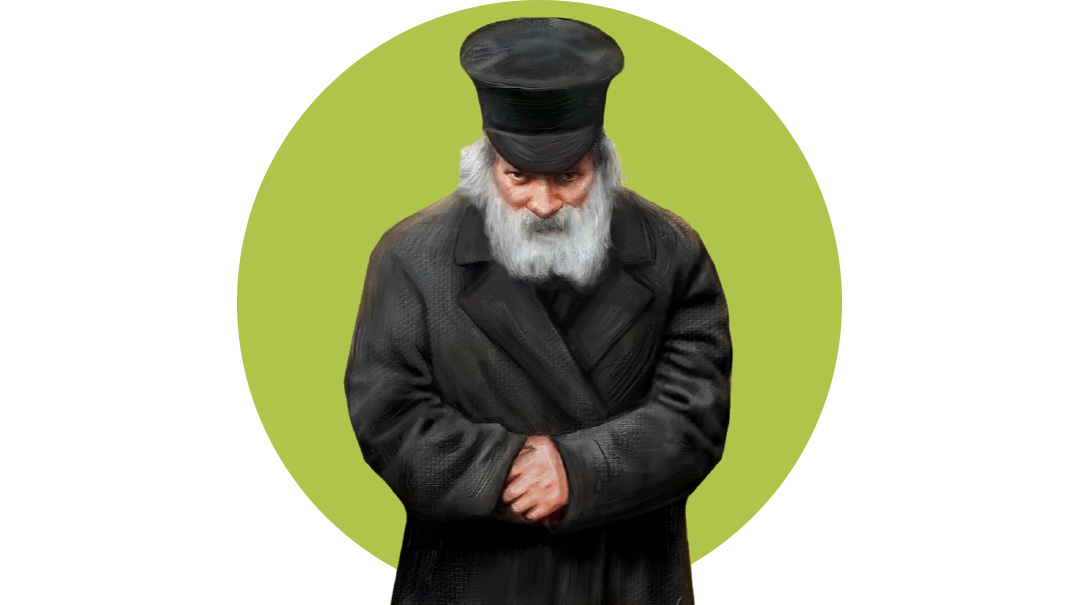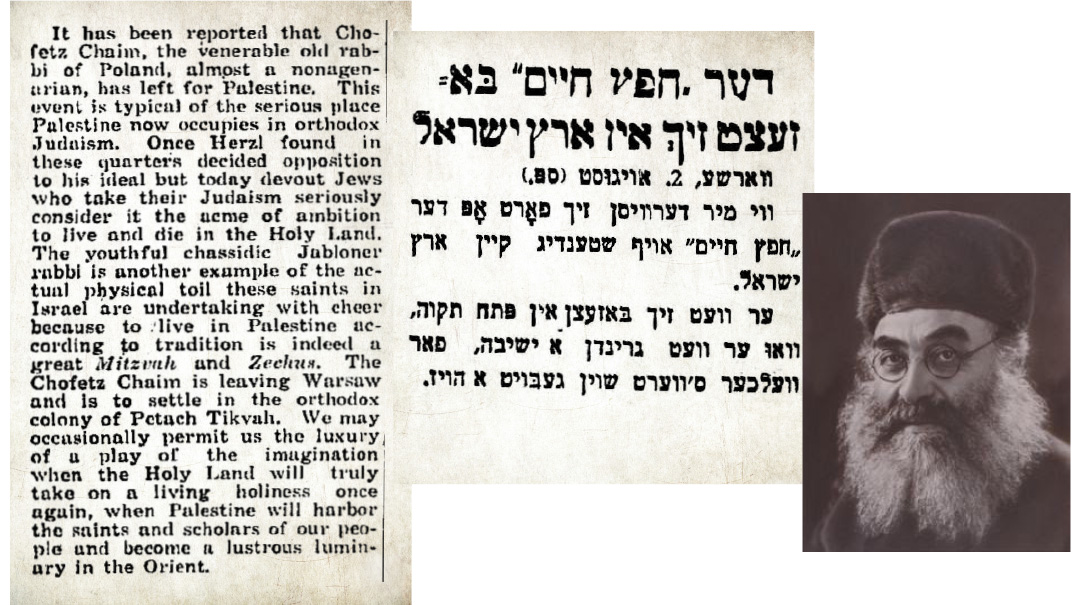The Chofetz Chaim Tries to Move to Eretz Yisrael
| September 5, 2023Rav Sonnenfeld reassured me, “To have the Chofetz Chaim come to Eretz Yisrael, I would sign on Hoshana Rabbah with both hands”

Location : Petach Tikvah
Document: Various newspaper clippings
Time: 1925
IT is difficult to overstate the Chofetz Chaim’s impact on modern Torah life. His works, notably Mishnah Berurah and his eponymous sefer on shemiras halashon, marked his first 75 years of life. In his later years, the man gedolei Yisrael of his era called “our Kohein Gadol” studied and disseminated the laws of Kodshim. This was to prepare for serving in the Beis Hamikdash, upon the imminent arrival of Mashiach. Near the end of his life, the Chofetz Chaim harbored one final wish: to settle in the Land of Israel. In honor of his 90th yahrzeit, we are pleased to present you with this story.
In His mercy, Hashem has granted me the privilege of reaching the ninth decade of my life, so I intend with His help to go up to the Holy Land, to find favor in her stones and to cherish her dust. I wish to bid farewell to my brethren and to my people who inhabit all these lands....
I now pour out my prayer of entreaty before Hashem, Guardian of Israel, that He should have compassion on His people, who live in tribulation and captivity, granting them survival and taking them from travail to salvation. May He send them His Mashiach, to bring them heartening messages and comfort....
My last request of you as I take my leave is concerned with the strengthening of Torah study and the yeshivos. That is the foundation and core of our life and the source of the merit that will lead us to redemption. I beseech my brethren to heed to this last request of mine. Guard the light of our holy Torah that illuminates our holy yeshivos.
—Chofetz Chaim, farewell letter to the Jewish People prior to his planned departure for Eretz Yisrael, Elul 1925
IN 1880, the rabbi of the town of Radin, Rav Yehuda Aryeh Leib Kwall, moved to Yerushalayim. Shortly afterwards, he penned a letter to a younger hometown acquaintance named Rav Yisrael Meir, who several years earlier had published his first sefer, called Chofetz Chaim. “In the diaspora, I didn’t feel the holiness of Shabbos. I only began to feel its holiness when I came to the Holy Land.“ This letter likely intensified the Chofetz Chaim’s lifelong yearning to move to Eretz Yisrael.
A year later, while the Chofetz Chaim was still in his forties, his oldest daughter, Gittel, became engaged to Rav Aharon HaKohein, author of Avodas Hakorbanos. The Chofetz Chaim included an unusual clause in the tenaim stipulating that he would provide the customary kest support for several years, but should he move to the Land of Israel in the interim, he would be absolved of the commitment.
When his next daughter, Sarah, became engaged to Rav Hirsh Levinson in 1884, he included the same caveat. Upon marrying his second wife, Miriam Freida, in 1904, the Chofetz Chaim asked her consent for moving to the Holy Land when the opportunity arose. And when his youngest daughter, Faiga, married Rav Mendel Zaks in 1923, he once again included the familiar clause in the tenaim. Over nearly half a century, the Chofetz Chaim’s desire for Eretz Yisrael never wavered, and he constantly made practical arrangements to move there.
The Chofetz Chaim’s attempts to emigrate were complicated by his great Torah projects in Russia: the Radin Yeshivah, the publication of his many seforim, and his rising leadership role. Following World War I, while still in Russia, he made plans to travel to Odessa in November 1920. From there he hoped to sail to Eretz Yisrael. It was even reported in the press that he was already on his way.
The chaotic situation during the Russian Civil War only compounded the delays caused by the passing of his beloved son-in-law Rav Hirsh Levinson. The Chofetz Chaim deemed it necessary to relocate the yeshivah, and he led them on a long trek out of the Soviet Union into independent Poland. Once there, he established the Vaad Hayeshivos together with Rav Chaim Ozer Grodzenski, to rebuild Torah life in the dire economic and religious conditions of the interwar years. His Holy Land plans were temporarily shelved.
In 1925, he felt the time was finally ripe to leave. The Jewish community in the Yishuv made preparations for his imminent arrival. On the Chofetz Chaim’s fourth yahrtzeit in 1937, Reb Moshe Blau, the head of Agudas Yisrael in Eretz Yisrael, shared the details of those preparations.
At the time, I was sitting amid a Simchas Beis Hashoeivah in the beis medrash of Rav Yosef Chaim Sonnenfeld during Chol Hamoed Succos of 1924. Among the visitors was Rav David Potash of Tel Aviv.
He called me aside and said, “The Chofetz Chaim wants to come to live in Eretz Yisrael. However, three things are needed for this: an entry permit for him and his family, 100 Palestine pounds to cover the travel expenses, and a suitable home.”
He, Reb David, would arrange the matter of the home. The entry permit and the money he left for me to arrange.
Before Hoshana Rabbah, I put the matter before Rav Yosef Chaim Sonnenfeld, with the earnest request that he should directly contact the British mandatory government regarding the entry permits. But then a question arose in my mind: Would our rabbi sign a visa application during Chol Hamoed? Never in his life had he written or signed anything on the intermediate days of a festival!
Rav Sonnenfeld reassured me, “To have the Chofetz Chaim come to Eretz Yisrael, I would sign on Hoshana Rabbah with both hands.”
I prepared the letter of application and brought it to Rav Sonnenfeld on Hoshana Rabbah, and he signed it with great joy.
Then my main worry began to press down on me, giving me no rest: How was I to raise 100 Palestine pounds? On Simchas Torah, I walked to my son’s home in the Shaarei Chesed section to pay him a Yom Tov visit. Coming toward me, I saw one of the residents of Shaarei Chesed I knew, accompanied by his family.
As we met and exchanged our festive greetings, this Yerushalmi said, “Do you know? People say that in our time there are no masters of ruach hakodesh left. Well, let me tell you an incident involving the Chofetz Chaim, and you will be convinced that even today there are masters of ruach hakodesh.”
When he finished his story, I responded to him, “The Chofetz Chaim wants to move to Eretz Yisrael. But 100 Palestine pounds are needed for the travel expenses. The matter must remain in secret.”
My friend became engrossed in thought. After a few minutes he said, “Tomorrow I will provide you with the 100 pounds, but on the condition that the Chofetz Chaim not know who gave it.”
This good Jew of Shaarei Chesed kept his promise, and I abided by his condition. The entry permit, too, arrived in good order. All was ready. Yet the fortune of Eretz Yisrael turned downward, and it was not privileged to welcome this great luminary into its midst. Israel was still in exile, and the Shechinah was still in exile with it. The Chofetz Chaim also remained in exile.
With the Chofetz Chaim imminently planning to leave, Rav Chaim Ozer Grodzenski and other Torah leaders begged him not to, protesting that the Vaad Hayeshivos desperately needed his leadership. He finally relented and agreed to delay his departure by five months to wrap up his communal affairs. In Elul 1925, his belongings were packed, while his books, printing materials, and personal possessions had already been shipped to Palestine.
A meeting was held in Vilna at the home of Rav Chaim Ozer to determine how to convince the Chofetz Chaim to stay. A committee of roshei yeshivah delegated Rav Boruch Ber Leibowitz to implore him to wait until after the holiday season, as his leadership was needed to stabilize the dire situation of the yeshivos.
The Chofetz Chaim responded, “Am I prisoner here, I can’t be allowed to leave as I please?” He finally conceded, postponing his departure until the last valid day of his travel documents. The day before his scheduled departure, on October 26, the Chofetz Chaim’s wife fell ill and had to be taken to Vilna to seek medical attention.
Though his plans had been thwarted, he made another attempt, applying for new documents as soon as his wife was healthy. On the day he received the second set of travel documents, his youngest daughter, Faige Zaks, fell ill. She eventually got better, but by this time the Chofetz Chaim himself was old and weak, and his doctors advised him not to make the strenuous journey in his precarious state of health. He finally resigned himself to the fate that he would be unable to settle in Eretz Yisrael.
The research and writings of the Chofetz Chaim’s student and biographer Rav Moshe Meir Yoshor was utilized in the preparation of this column.

(Middle) A report from a Warsaw newspaper states that the Chofetz Chaim is en-route to the Land of Israel where he will settle in Petach Tikvah, where a yeshivah is being built on his behalf
(Right) Rav Reuven Katz, a leading student of the Chofetz Chaim and president of the Radin yeshivah, served as rav of Petach Tikvah and also played a major role in trying to bring the Chofetz Chaim to his city
The Chofetz Chaim’s Home
In preparation for the Chofetz Chaim's arrival in 1925, a home was built for him in Petach Tikvah, next to the Lomza yeshivah on Rechov Herzl. Though he never resided in it, the yeshivah used it for several purposes.
For many years, the first floor served as the dining room. Rav Elya Dushnitzer, a close disciple of the Chofetz Chaim who taught in the yeshivah, resided on the second floor. Rav Dov Zochovsky, the yeshivah's mashgiach, occupied the second apartment on that floor. Rav Nosson Zochovsky recalls that even years later, letters would still arrive at the house addressed to "Zochovsky Family, Beis HaChofetz Chaim, Petach Tikvah."
Poles in Palestine
Polish president Ignacy Moscicki paid a historic visit to the Chofetz Chaim in Radin on 24 Elul 1929. This unprecedented visit by a head of state to the backwater shtetl of Radin to confer with a Jewish sage was for the purpose of discussing government regulation of religious affairs and reforms in Jewish education. But the Chofetz Chaim also made a point of expressing his gratitude for the actions of the Polish consul to Palestine, who had extended his assistance to the victims of the recent deadly riots there — many of whom were Polish citizens. The Holy Land and the welfare of its inhabitants were constantly on the Chofetz Chaim’s mind.
The Chofetz Chaim’s 90th yahrtzeit is 24 Elul.
This column is dedicated to the memory of Rav Avraham Nachman ben Zev, who dedicated his life to helping others and sharing the vital message of the Chofetz Chaim.
(Originally featured in Mishpacha, Issue 977)
Oops! We could not locate your form.






